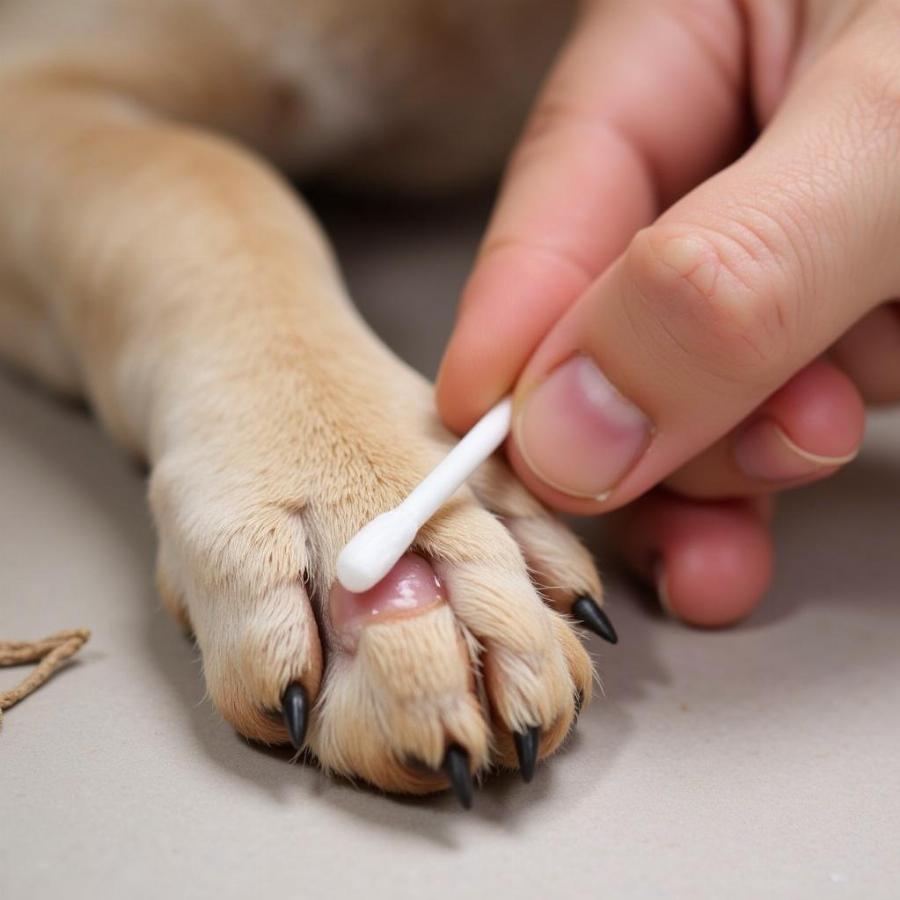Choosing the right antibiotic ointment for your dog can be tricky. You want something that will effectively treat minor wounds and skin infections, but you also need to make sure it’s safe for your furry friend. This article will guide you through selecting and using safe antibiotic ointments for dogs, helping you keep your canine companion healthy and happy.
Understanding When to Use Antibiotic Ointment on Dogs
Antibiotic ointments are helpful for superficial wounds like minor cuts, scrapes, and abrasions. They help prevent infection and promote healing. However, it’s crucial to remember that not all human antibiotic ointments are safe for dogs. Some contain ingredients that can be toxic if ingested, which is a real possibility considering dogs tend to lick their wounds.
Safe Antibiotic Ointments for Dogs
So, what antibiotic ointment is safe for dogs? Veterinarians generally recommend ointments containing bacitracin or mupirocin. These are considered safe for topical use on dogs and are effective against a range of bacteria. Always check the label to ensure the ointment doesn’t contain other ingredients that could be harmful to your dog, such as neomycin or pain relievers like ibuprofen.
“Always consult with your veterinarian before using any new medication on your dog, even topical ointments,” advises Dr. Emily Carter, DVM, of the Animal Care Clinic. “They can help you choose the right product and dosage based on your dog’s specific needs and health condition.”
Can You Use Neosporin on Dogs?
While Neosporin is a common household antibiotic ointment, it’s generally not recommended for dogs. It contains neomycin, which can cause allergic reactions in some dogs and can be toxic if ingested in large amounts. While small amounts might not cause immediate harm, consistent licking can lead to a buildup of the drug in their system. If you’re unsure about which antibiotic ointment to use, it’s always best to err on the side of caution and consult your veterinarian. They can recommend a safe and effective alternative. can you put neosporin on dogs cuts
Applying Antibiotic Ointment: A Step-by-Step Guide
- Clean the wound: Gently clean the affected area with warm water and mild soap. Pat dry with a clean cloth.
- Apply a thin layer: Apply a small amount of the recommended antibiotic ointment directly to the wound. Avoid over-applying.
- Prevent licking: Use an Elizabethan collar or bandage to prevent your dog from licking the ointment. Ingestion can lead to stomach upset and other complications.
- Monitor the wound: Check the wound daily for signs of improvement or infection. If the wound worsens, contact your veterinarian immediately.
 Applying ointment to a dog
Applying ointment to a dog
When to Seek Veterinary Care
While antibiotic ointments can treat minor wounds, some situations require professional veterinary care. Deep wounds, punctures, bites, or wounds showing signs of infection (redness, swelling, pus, or a foul odor) should be evaluated by a veterinarian.
“Don’t hesitate to contact your veterinarian if you’re unsure about the severity of your dog’s wound,” says Dr. Maria Sanchez, DVM, specializing in canine dermatology. “Early intervention can prevent complications and ensure proper healing.”
Conclusion
Choosing the right antibiotic ointment is vital for your dog’s health. Always opt for veterinarian-recommended options containing bacitracin or mupirocin. Avoid using human ointments containing potentially harmful ingredients like neomycin. Remember to monitor the wound and consult your vet if you notice any signs of infection or if the wound doesn’t improve. By following these guidelines, you can effectively treat minor wounds and keep your furry friend safe and comfortable.
FAQ:
- What if my dog licks the antibiotic ointment? Contact your vet immediately. While small amounts may not cause severe harm, large amounts can be toxic.
- Can I use human triple antibiotic ointment on my dog? No, avoid using triple antibiotic ointments formulated for humans. They often contain neomycin, which can be harmful to dogs.
- How long should I use antibiotic ointment on my dog? Continue using the ointment until the wound is healed, as directed by your veterinarian.
- What are the signs of an infected wound? Redness, swelling, pus, a foul odor, and increased pain are signs of infection.
- What should I do if my dog’s wound isn’t healing? Consult your veterinarian immediately for further evaluation and treatment.
- Are there any natural alternatives to antibiotic ointments for dogs? Some natural remedies like honey or aloe vera have antibacterial properties, but always consult your vet before using them on your dog’s wounds.
- Where can I buy safe antibiotic ointments for my dog? Your local veterinary clinic or reputable pet supply stores are good places to purchase veterinarian-approved ointments.
Other questions you may have:
- Is triple antibiotic ointment safe for dogs? is triple antibiotic ointment safe for dogs
- Can you put triple antibiotic ointment on a dog? can you put triple antibiotic ointment on a dog
- Can you use bacitracin on dogs? can you use bacitracin on dogs
Beaut Dogs is your trusted source for comprehensive information on dog breeds and care. We provide expert advice on everything from health and nutrition to training and behavior. When you need expert advice, please email us at [email protected] so Beaut Dogs can give you detailed and accurate answers. Visit https://beautdogs.com today!